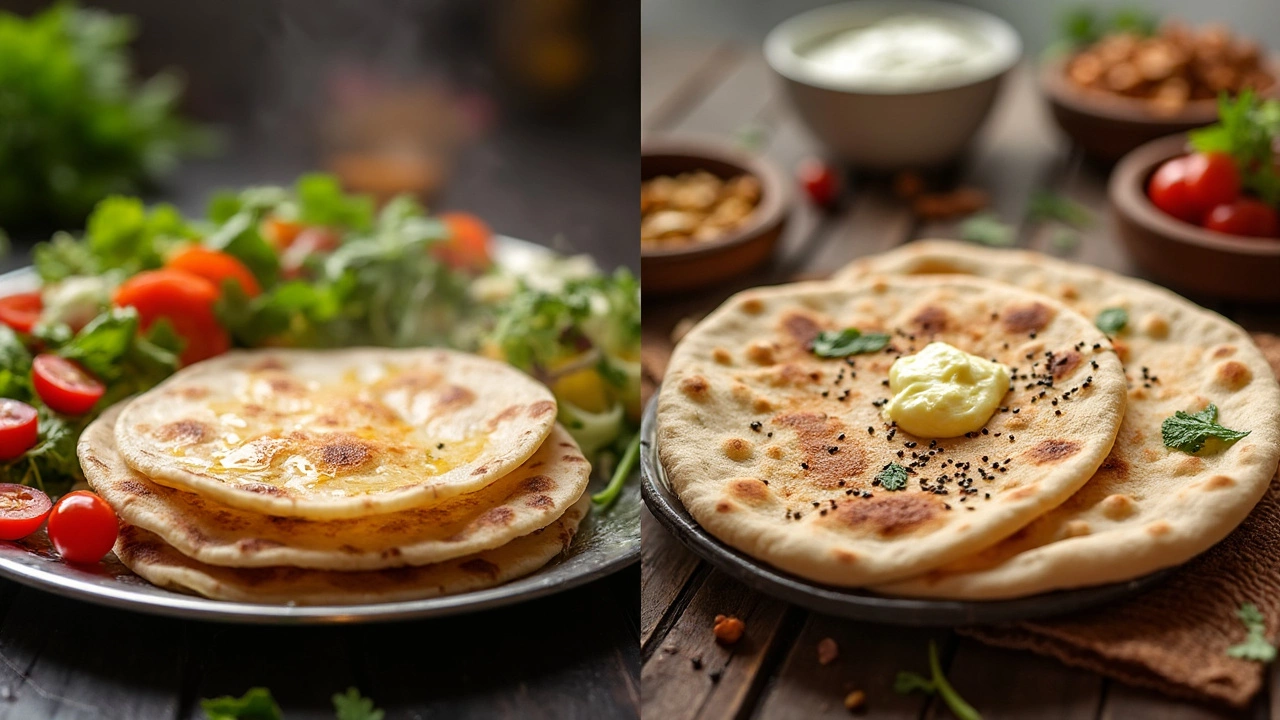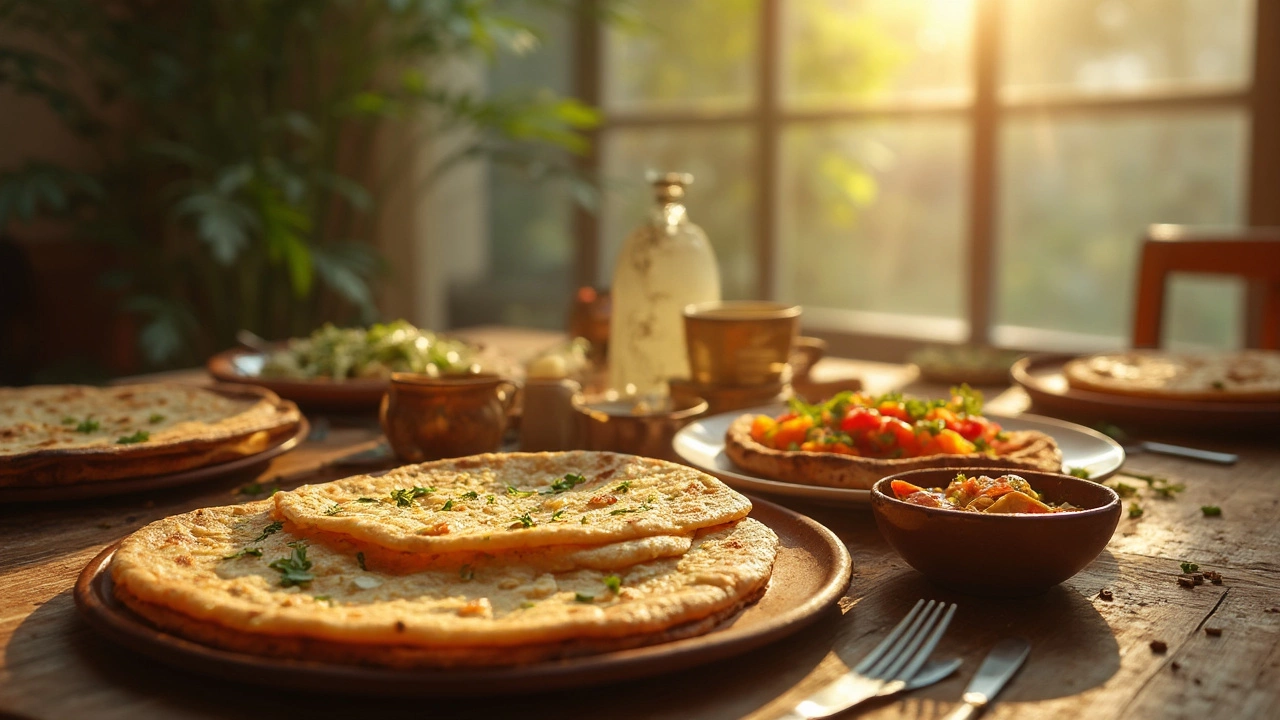Roti vs. Naan: Healthier Choice Revealed
 Feb, 19 2025
Feb, 19 2025
Choosing between roti and naan isn't just about flavor; it's about fueling your body right. If you've ever asked yourself how much calories in 1 roti or wondered about the difference between these two beloved breads, you're in the right place.
Let's break it down simply: the average calories in 1 roti is around 70. This amount can change depending on size and ingredients. If you pair it with sabzi, the calories in 1 roti and sabzi vary, but sabzi usually adds more nutrients than calories. Adding ghee to your roti? Expect the calories in 1 roti with ghee to go up, reaching closer to 100.
- Understanding Roti and Naan
- Roti and Its Caloric Content
- Delicious Naan: A Taste Explosion
- Which Bread is Healthier?
- Making Healthier Choices with Roti and Naan
Understanding Roti and Naan
Alright, let's dive into these two staples of Indian cuisine: roti and naan. Whether you’re enjoying a spicy curry or a savory sabzi, these bread options are usually front and center. But what actually goes into making these delicious breads?
Roti: The Everyday Staple
Roti is a type of unleavened bread, meaning it doesn’t use yeast to rise. Made from whole wheat flour, it’s a basic but essential part of many meals, often enjoyed with various dishes like lentils or vegetables. A key feature of roti is its simplicity; it’s just flour, water, and a pinch of salt. The beauty of roti lies in its versatility.
An average roti has about 70 calories, so it’s a great option if you're watching your intake. When you hear people worried about how much calories in 1 roti, they can relax a bit knowing it's mostly healthy carbs and provides dietary fiber too.
Naan: The Delightfully Fluffy Bread
Naan, on the other hand, is often seen as the richer cousin. Made traditionally with white flour, yeast, and yogurt, naan is fluffy and has a slightly chewy texture. You might find naan brushed with butter or garlic for extra flavor.
Here's the kicker: naan usually has more calories than roti, thanks to its ingredients, which can clock in at anywhere between 150 to 300 calories per piece. So, if you’re opting for naan, consider having it with moderation.
Comparing the Two
These tasty breads have their unique places in meals. Roti, with its lower calorie count, may be a wiser choice if you're aiming for a healthier diet. For those special occasions or cheat days, naan can be a delightful treat.
If making better health choices is your goal, it starts by knowing the difference in calorific content and making mindful decisions. Whatever you pick, both breads bring their own flavors and joy to the table!
Roti and Its Caloric Content
Identifying the precise caloric content of your favorite bread can transform your dietary choices. Starting with roti, often a staple in Indian cuisine, it's crucial to grasp what you're consuming.
An average roti packs about 70 calories, making it a relatively light choice among breads. It's made from whole wheat flour, water, and salt, making it a fiber-rich option with minimal calories. But remember, sizes may vary, and so do the calories.
Breakdown of Calories
Want to get into specifics? Here's what makes up those 70 calories:
- Carbohydrates: 15 grams
- Protein: 3 grams
- Fat: 1 gram
Deciding to add some twists to your roti? Say, you're thinking about spreading a little ghee. The calories in 1 roti with ghee can rise to about 100 calories. Ghee offers good fats, but moderation is key.
Customizing Your Roti
Worried about how to keep your roti healthy yet satisfying? Here's a quick guide:
- Consider adding extra fiber by mixing in some oat or barley flour.
- If preparing roti for sabzi, which adds nutrients, opt for veggies rich in vitamins to balance your plate.
- If calorie counting, opt for portion control rather than skipping ghee entirely.
Swapping a regular roti for a whole grain or multi-grain version can also be an excellent way to boost dietary fiber without adding many calories.
Trimming unnecessary calories helps make better choices, whether you're looking for a quick lunch solution or aiming for long-term lifestyle changes. Here, understanding roti calories is your first step towards informed decisions.

Delicious Naan: A Taste Explosion
Naan lovers, assemble! If you've ever tasted this delightful Indian bread, you know it's more than just a side dish; it's an experience. The fluffy texture and rich flavor profile are just unbeatable. But how does it stack up health-wise?
Naan is baked in a tandoor, giving it that signature smoky taste. It's part of what makes naan so irresistible when compared to roti. However, this baking style often involves refined flour and more oil or butter than other bread, impacting its nutritional value. If you're concerned about calories, you might want to know that one naan can pack about 260 calories, sometimes more if it includes fillings or extra toppings.
Problem: High-Calorie Naan
The main issue with naan is that it can be a calorie-dense option because of its traditional prep methods. For anyone watching their calorie intake, this might seem daunting.
Solution: Making Naan Healthier
- Opt for whole-wheat naan to cut back on empty calories.
- Choose naan with minimal butter or oil, or prepare it at home with healthier alternatives like olive oil.
- Pair naan with lighter dishes, such as salads or grilled veggies, to balance out your meal.
For a quick breakdown of naan ingredients vs. calories:
| Ingredient | Calories |
|---|---|
| Refined Flour | 100 |
| Butter/Oil | 60 |
| Ghee (Optional) | 70 |
| Yeast & Other Additives | 30 |
With these tips, you can enjoy your naan without the calorie guilt. So next time you're tempted by this delectable bread, remember that smart choices can let you savor the flavors you love while staying health-conscious.
Which Bread is Healthier?
When it comes to choosing between roti and naan, it's not just about taste—it's also about what's better for your health. So, which one should you pick? Let's dive into the details.
Caloric Content Breakdown
Let's start with calories. On average, the calories in 1 roti are about 70, but add ghee and that number goes up to around 100. Compare this to naan, where one piece can be as high as 250 calories, thanks to the refined flour, sugar, and even yogurt used in the dough. So, if you're watching calories, roti is the clearer choice.
Ingredients Matter
Naan often contains refined flour, which isn't as nutrient-rich as whole wheat. Roti is usually made from whole wheat flour, offering more fiber—which is great for digestion. Whole grains also help in keeping you full longer, reducing the temptation for those late-night snacks.
Dietary Considerations
If you're on a specialized diet, knowing these facts can be helpful. For gluten-free diets, neither traditional roti nor naan would be suitable. But there are gluten-free roti recipes out there using alternatives like chickpea flour.
The Verdict
While naan definitely wins on the taste front for many due to its chewy and buttery texture, roti shines brighter health-wise. If you want a healthier meal option, especially if you're watching calorie intake, roti is the better choice.
| Bread Type | Calories | Main Ingredient |
|---|---|---|
| Roti | 70 | Whole Wheat Flour |
| Naan | 250 | Refined Flour |
So, next time you're at a restaurant or cooking at home, consider these facts to make a smart choice that suits both your taste buds and your dietary needs.

Making Healthier Choices with Roti and Naan
We all want to enjoy our meals without the guilt, right? When it comes to roti and naan, the trick is knowing how to make each option work for you. Here's how you can make more informed decisions.
Understanding Your Goals
First, think about what you're aiming for. Are you cutting calories, boosting energy, or keeping it balanced? If calories are your main concern, remember, roti calories are generally lower than naan's due to the absence of butter and cream. With roughly 70 calories in 1 roti, it fits well in a calorie-conscious diet.
Choosing the Right Ingredients
What goes into your bread matters. For roti calories, stick to whole wheat flour or even try ragi for more fiber. Naan often includes yogurt and sometimes butter, increasing its moisture and calorie content. Opt for whole wheat naan or consider reducing toppings like butter.
Pairing Wisely
Find a good balance by watching what you pair your bread with. The calories in 1 roti and sabzi can be lower when you choose veggie-loaded sabzis over creamy ones. Keep an eye on portion sizes too.
Cooking with Care
When making roti at home, use a non-stick pan to cut down on oil. If you love roti with ghee, try using just a smear rather than a spoonful. Every small change adds up.
A Quick Comparison
Here's a brief look at the differences:
| Item | Calories | Main Ingredients |
|---|---|---|
| Roti | ~70 | Whole Wheat Flour, Water |
| Naan | 100-150 | All-Purpose Flour, Yogurt, Butter |
Making healthier choices isn't about sacrificing flavor; it's about being smarter with your picks. So next time you're deciding between roti and naan, remember these tips to keep your meals both tasty and healthy!